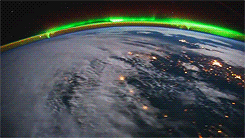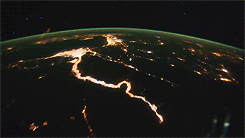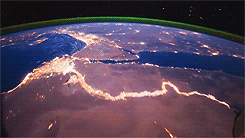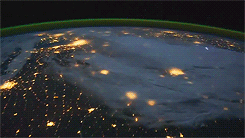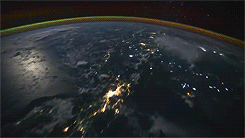Star Forming Region S106

Star Forming Region S106
Massive star IRS 4 is beginning to spread its wings. Born only about 100,000 years ago, material streaming out from this newborn star has formed the nebula dubbed Sharpless 2-106 Nebula (S106), pictured above. A large disk of dust and gas orbiting Infrared Source 4 (IRS 4), visible in dark red near the image center, gives the nebula an hourglass or butterfly shape. S106 gas near IRS 4 acts as an emission nebula as it emits light after being ionized, while dust far from IRS 4 reflects light from the central star and so acts as a reflection nebula. Detailed inspection of images like the above image has revealed hundreds of low-mass brown dwarf stars lurking in the nebula’s gas. S106 spans about 2 light-years and lies about 2000 light-years away toward the constellation of the Swan (Cygnus).
More Posts from Outofambit and Others
Ocean Ramsey and her team encountered this 20 ft Great White Shark near the island of Oahu, Hawaii. It is believed to be the biggest ever recorded
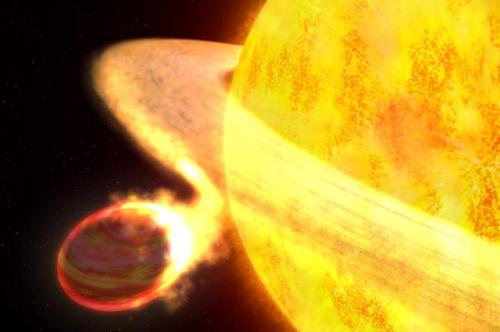
Most Amazing Exoplanets
The term ‘exoplanet’ applies to any planet outside of our solar system. At last count, we have identified 3,538.
Out of the thousands of planets we know about, some of them are incredibly bizarre compared to what we are used to seeing in our own solar system. Here are some exoplanets with very unique characteristics:
Kepler-78b
The most astounding fact about Kepler-78b is that it shouldn’t even exist, according to our current knowledge of planetary formation. It is extremely close to its star at only 550,000 miles (900,000 kilometers). As a comparison, Mercury only gets within 28.5 million miles (45.9 million kilometers) of the sun in the nearest point of orbit. With that proximity, it isn’t clear how the planet could have formed as the star was much larger when the planet formed. With its current distance, that would mean it formed inside the star, which is impossible as far as we know.
The planet itself is only slightly larger than Earth, though surface conditions are markedly different. The temperature on the surface is estimated to be 4300° F (2400° C), which is nearly nine times as hot as the temperature on Venus. Unfortunately for Kepler-78b, it is likely that the star’s gravitational pull will gradually bring the star closer and totally consume it in the next 3 billion years.
WASP-12b
While Kepler-78b still has about 3 billion more years before getting consumed by its star, the process is well underway for WASP-12b. This exoplanet is actively getting pulled apart by its parent star, much to the delight of astronomers who can watch the process unfold. So much material has been pulled away from the planet, it has been pulled into an oblong football shape. Astronomers have estimated that WASP-12b has about 10 million more years until it is completely pulled apart by the star.
The planet is described as a “hot Jupiter” as it is a gas planet that is about 40 percent larger than Jupiter. It is currently so close to its star that it only takes 1.1 Earth days for the planet to complete a full orbit. The star, WASP-12, is G-type main sequence star, just like our own sun. It is located about 800 lightyears away in the Auriga constellation.
TrES-2b
TrES-2b has been dubbed the “dark planet” because it does not reflect light. If we were able to view it directly, it would likely just look like a coal-black ball of gas. At 1800°F (1000°C) the planet is way too hot for clouds, which would help reflect the star’s light. The red tinges are areas of superheated gas. Other darker planets only reflect about 10% of the star’s light, but TrES-2b only reflects about 1%, making it the darkest planet ever discovered.
Why is TrES-2b so dark? Scientists aren’t quite sure. Right now, the best guess is that the majority of the planet’s composition is something like sodium or potassium which absorbs light. This dark world is located about 750 lightyears away in the Draco constellation.
HD 189773b
HD 189773b is pretty exciting. It is relatively close, at only 63 lightyears away. It is also the first planet to have its color determined and it turned out to be a pretty blue planet, just like Earth. Unlike Earth, however, HD 189773b is a gas giant with a temperature that reaches a sweltering 1800°F (1000°C). The weather gets more extreme, because intense pressure and temperature turns silicate particles in the atmosphere into glass, which then rains down. As if that doesn’t sound dangerous enough, the winds have been estimated to gust at 4,000 mph (7,000 km/h) which really whips those glass particles around.
55 Cancri e
55 Cancri e is twice the size of Earth but is nearly 8 times more massive and twice as dense. Last fall, researchers deduced that the mass of the planet was largely carbon. Due to the pressure and surface temperature of 4892°F (2700°C) it very well could have formed diamond. It is so close to its parent star it takes a mere 18 hours for the planet to complete a full orbit.
55 Cancri e is only about 40 light-years away from us in the Cancer constellation. The parent star is much more carbon than our own sun, so it might be too surprising that planet e is also carbon-rich. From there, it isn’t much of a stretch to assume that the other four known planets in the system would also have a high carbon content.
Because of these extreme conditions, astronomers don’t believe that 55 Cancri e has an atmosphere, making it a poor candidate for the possibility for life. However, it is close enough for astronomers to use it to test hypotheses about planetary formation.
PSR B1620-26b
Nicknamed “Methuselah,” PSR B1620-26b is the oldest known exoplanet. The planetary system formed approximately 12.7 billion years ago, when the Milky Way galaxy was in its infancy. It is located in the Scorpius constellation about 12,400 lightyears away.
Methuselah orbits binary stars and goes around them in a circumbinary orbit. As if Methuselah’s age isn’t interesting enough, the fact that it orbits two mismatched dead stars is quite unusual. One of the stars is a pulsar and the other is a white dwarf. Since Methuselah is found in a dense star cluster, astronomers initially thought it could be a star as well, and would be considered a brown dwarf. Measurements from the Hubble would confirm that Methuselah is a planet, and it remains the oldest one we’ve ever discovered.
TrES-4
Located 1,400 lightyears away in the Hercules constellation, TrES-4 is the largest exoplanet we have discovered so far. Though it is over 1.7 times the size of Jupiter, it has an extremely low density and is categorized as a “puffy” planet. The planet’s density is about the same as cork, which came as quite a shock. Astronomers attribute this to extreme heat of 2,300° F (1,260° C) due to is proximity to the star. At only 4.5 million miles (7.2 million kilometers) away from its sun, TrES-4 is able to complete an orbit in three Earth days.
Gliese 436 b
30 lightyears away in the constellation Leo, Gliese 436 b is a planet that is about as massive as Neptune. The planet also happens to be covered in burning ice - though the ice isn’t anything like what we’re used to. The extreme pressure of the planet forces the water to stay in solid form, even though the temperature exceeds 570° F (300° C). The outer layer of the solid water is superheated and comes off as vapor. Water has over 10 solid states, not including common ice.
In its present position, the water would not have been able to condense down into a solid, indicating that it migrated toward its sun after it formed.
Thing I’ve been mulling over for a while: some really good YA fantasy novels of my childhood (Young Wizards - no one who knows me is surprised by this) really emphatically gave me tools to understand and dismantle my own “white supremacist delusion,” as Sonya Renee Taylor puts it. The construction of the cosmos in these books formed my worldview at a really early age. They have helped me, decades later, to believe deeply and truly in both my own ability to support and uphold Evil in all of its guises, no matter how ‘good’ or ‘nice’ I may inherently see myself to be - and my own power to dismantle Evil in all its guises, within myself, as well as in the world beyond myself.
I was watching this IG live video where Taylor powerfully explains how important it is to shift from seeing whiteness as something intrinsically ours to possess rather than as the result of a dehumanizing system that we can - and in fact are ethically called upon to - uproot. I understand Taylor to be saying that I, as a person assigned power by whiteness, have a duty to continually identify and reject the delusions of whiteness starting with myself.
There’s an image Taylor uses, in this video, of searching inside of yourself for the spaces where this toxic ideology of whiteness has taken hold - and to find and uproot it. And immediately I saw a climactic moment from High Wizardry, one where Dairine has a realization about how intimately entropy has its hold upon her:
She stopped, as the answer rushed into her mind from the manual. Where entropy is, it said, there its creator also is, either directly or indirectly…
I’m a product of this universe, after all, she had said to the mobiles. It’s in me too…
Her heart turned over inside her as she came to know her enemy. Not a Darth Vader, striding in with a blood-burning light-sabre, not something outside to battle and cast down, but inside. Inside herself. Where it had always been, hiding, growing, waiting until the darkness was complete and its own darkness not noticeable any more. Her Enemy was wearing her clothes, and her heart, and there was only one way to get rid of It…
She was terrified. Yet this was the great thing, the thing that mattered […]
I’d hazard a guess that many of us have a primary conditioning to see evil precisely as “something outside to battle and cast down.” I say this about evil in general; I think it’s probably extra true for the ways that white people approach the evil of white supremacist delusion. I see it a lot with the teenagers that I now teach: the actively anti-racist white kids who really want to march, to have hard conversations with other people, to change laws, to show up at city hall meetings…and who don’t understand that, while those are all good and important things to be doing, if they are all you are doing, they will not be enough. They are all ways of seeing the problem as “something outside to battle and cast down” instead of as something that is LITERALLY “wearing [your] clothes, and [your] heart.”
The good news - also from High Wizardry - is the possibility of full and complete liberation on the other side of the recognition, and the reckoning that follows. The snatches of it glimpsed within this life, the work of widening the ground… The belief (which Duane’s world offered me, and which my Christianity never did) that even the one who dreamed Evil into being can be liberated and redeemed from it…and that that, and no less, is the scope of the work.
(YW also taught me, perhaps most importantly of all, that this work is collective and done best when part of an ever-widening family / network / team.)
I would find a way to be there.
wowww
things that would be expensive: renting an RV
things that would actually probably be less expensive: inventing technology for teleports
yall arent ready yet but one day were going to talk about how the young wizards series is better than harry potter. the language is more complicated but trust me, its better
I’ve got another question for you (sorry for asking so many questions about the young wizards series). The concepts of the Wizards Manual and the Speech. Let’s say, for instance, a wizard isn’t mathematically minded and has a natural bent towards poetry and literature, could the Speech take the form of poetry and could the Wizard’s manual be a mixture of modalities (pen and paper, laptop, and headphones)?
Well, this question has to be handled in two parts.
Can a wizard use something besides the Speech to do wizardry? No. There's only one language in which the Universe was built (though numerous recensions of that).
But that said: want to do spells in which the Speech is structured like poetry? Well, sure, why not? Poetry (when it's not free verse) is some of the most structured stuff there is: it'd work perfectly. (As long as you were really careful with the scansion...) And other forms of artistic structure could also work.
As regards the math end of things: you could make a case that both Nita's and Kit's Manuals (maybe more Nita's...) are mathematically- or scientifically-aligned because both their mindsets lean (or leaned) that way. But are there wizards constructing spells that look more like artwork than equations? Almost certainly. (There's at least one reference in Games Wizards Play to wizards dancing spells in the Speech rather than speaking it. Not to mention one of the wizards working with the event organizers for the Invitational, a graphic designer who was embedding the Speech into fonts...)
Secondary to all this: can the Manual be used in more than one modality? I don't see why not. The master project of "porting over" the Manual into more modern and easier-to-manage instrumentalities is first mentioned in The Book of Night with Moon—where Ehef, one of the feline wizards living and working at NYPL is a supervisor on the project. And this would almost certainly be a continuing effort, resulting in items like the WizPhone that Nita trialed at Kit's urging some while back. (And of course Spot, who started out with Dairine as a desktop and upgraded to a laptop along the way.) The attitude of the Powers that Be would certainly be that they want to make doing wizardry easier for qualified people, not harder. So, mix and match among modalities? Sure. (And at least you'd never have to worry about them staying in synch...) :)
...As for pen and paper: it's likely enough that the Speech was for many centuries in writing-centric cultures most routinely written longhand (after it broke out of cuneiform and hieroglyphics...). Probably there are even now wizards who prefer to do their spell structuring longhand—who knows, maybe even with fountain pens. (In fact, now I've managed to make myself suspicious about the work habits of a couple of people I know...) :)
Anyway: HTH!

Cosmic Dance: Creation of Supermassive Black Holes
Evolution of two equal sized galaxies colliding and forming a massive cloud of gas that will collapse into black hole.
Credit: Ohio State University
-
 daughteruniverse reblogged this · 10 years ago
daughteruniverse reblogged this · 10 years ago -
 lambieandbellybutton reblogged this · 10 years ago
lambieandbellybutton reblogged this · 10 years ago -
 mopbucketwizard reblogged this · 10 years ago
mopbucketwizard reblogged this · 10 years ago -
 mopbucketwizard liked this · 10 years ago
mopbucketwizard liked this · 10 years ago -
 sp-oc-k-blog liked this · 10 years ago
sp-oc-k-blog liked this · 10 years ago -
 sp-oc-k-blog reblogged this · 10 years ago
sp-oc-k-blog reblogged this · 10 years ago -
 hunnislutt liked this · 10 years ago
hunnislutt liked this · 10 years ago -
 acciosilver reblogged this · 10 years ago
acciosilver reblogged this · 10 years ago -
 shapeshifting-bisexual reblogged this · 10 years ago
shapeshifting-bisexual reblogged this · 10 years ago -
 bundysaspirinbottle reblogged this · 10 years ago
bundysaspirinbottle reblogged this · 10 years ago -
 videoboy reblogged this · 10 years ago
videoboy reblogged this · 10 years ago -
 avatar27 liked this · 10 years ago
avatar27 liked this · 10 years ago -
 blogshowhost reblogged this · 10 years ago
blogshowhost reblogged this · 10 years ago -
 pointzeroworld liked this · 10 years ago
pointzeroworld liked this · 10 years ago -
 upsilons-musings reblogged this · 10 years ago
upsilons-musings reblogged this · 10 years ago -
 crednescodpeace liked this · 10 years ago
crednescodpeace liked this · 10 years ago -
 stargazer333 liked this · 10 years ago
stargazer333 liked this · 10 years ago -
 sweettastebuds reblogged this · 10 years ago
sweettastebuds reblogged this · 10 years ago -
 sweettastebuds liked this · 10 years ago
sweettastebuds liked this · 10 years ago -
 hypocrisycity reblogged this · 10 years ago
hypocrisycity reblogged this · 10 years ago -
 autumnal-rides reblogged this · 10 years ago
autumnal-rides reblogged this · 10 years ago -
 izmagizz reblogged this · 10 years ago
izmagizz reblogged this · 10 years ago -
 laylalb16-blog liked this · 10 years ago
laylalb16-blog liked this · 10 years ago -
 ladii-aj-2-flyy liked this · 10 years ago
ladii-aj-2-flyy liked this · 10 years ago -
 turkhimself reblogged this · 10 years ago
turkhimself reblogged this · 10 years ago -
 turkhimself liked this · 10 years ago
turkhimself liked this · 10 years ago -
 ounhime liked this · 10 years ago
ounhime liked this · 10 years ago -
 kingfroggie liked this · 10 years ago
kingfroggie liked this · 10 years ago -
 helvatica liked this · 10 years ago
helvatica liked this · 10 years ago -
 love-when-it-reigns reblogged this · 10 years ago
love-when-it-reigns reblogged this · 10 years ago -
 love-when-it-reigns liked this · 10 years ago
love-when-it-reigns liked this · 10 years ago -
 lgir reblogged this · 10 years ago
lgir reblogged this · 10 years ago -
 lgir liked this · 10 years ago
lgir liked this · 10 years ago -
 verusmihi liked this · 10 years ago
verusmihi liked this · 10 years ago -
 resurrectionblues liked this · 10 years ago
resurrectionblues liked this · 10 years ago -
 the-creeps liked this · 10 years ago
the-creeps liked this · 10 years ago
A personal temporospatial claudication for Young Wizards fandom-related posts and general space nonsense.
288 posts
